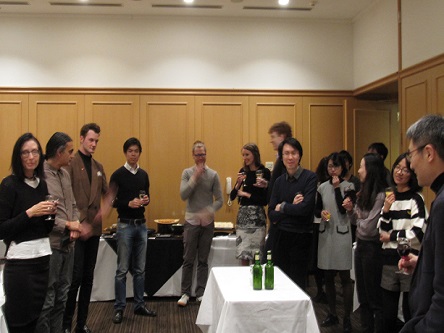【報告】 ANU-PKU-UTokyo Winter Institute 2018 (6)
After many thought-provoking presentations and much heated discussion, this year’s Winter Institute came to a close on January 26.
The day itself was a far more casual affair than previous sessions, giving the participants a much-needed to chance to wind-down and explore some well-known sites near Hongo Campus. Here, passionate intellectual debate on the concept of coexistence in different fields of academia was exchanged for a brisk stroll through Ueno and a brief stop at the Tokyo National Museum.
Starting at the IASA building on Hongo Campus, where the participants shared their final lunch together, our group made its way first to the nearby Yushima Tenmangu for a quick cup of amazake and a small walk around the shrine. Cold weather notwithstanding, we then enjoyed a short excursion through the Ueno environs, eventually making our way to Ueno Park and the National Museum.
Here, we were greeted by Ms. Endo, who kindly guided us on a short tour of the main building’s upper floor in which the museum’s fine collection of precious Japanese artworks and antiquities from the Jomon period to the nineteenth century is exhibited. While this was, of course, a chance for us to view some truly beautiful artistic creations, it also provided a valuable means of seeing how the narrative flow of Japanese history has been constructed and expressed as a continuous thread in aesthetic terms. After a multi-day symposium in which the themes of critical area studies and coexistence gave rise to many critical debates on the complex relations of disparate peoples both between nations and within nations, the opportunity to see a material expression of the ‘narrativization’ of Japan within the space of a national museum allowed us to reflect on these debates and the national space (a national university, I might add) within which they occurred.
This museum tour was then followed by a break before we reconvened in the evening to share a farewell dinner. At this final event many warm words were exchanged between the participants, with encouraging reflective speeches given by Professors Nakajima, Ishii and Cunio. Having completed a successful and compelling joint institute this year, our thoughts then turned to the prospect of next year’s institute at the Australian National University. Given the superb quality of this year’s exchange, I expect that the upcoming ANU institute will only produce even more profound and engaging intellectual dialogue between members of the participating universities.

Indeed, the final day of the institute invites broader reflection on the character of the entire institute itself. From my own perspective, the central themes of critical area studies and coexistence provided a discursive environment in which the truly interdisciplinary nature of the institute could flourish. The field of area studies itself provides a space for academic research from different fields to come into dialogue with each other, allowing for the development of substantial connections between different modes of research that may otherwise remain isolated from each other. With contributions from scholars working in comparative literature, musicology, Chinese philosophy, medical history, anthropology and urban sociology, our institute traversed the boundaries of discipline while remaining centred around a common theme with which all our diverse research projects and disciplinary backgrounds could engage.
Yet this was not simply an area studies symposium in the way that scholars from disparate backgrounds are united through their studies of a specific area like East Asia or North Africa. In specifically positioning this year’s institute as a set of discussions around critical area studies, we questioned the very constitution of an ‘area’ and revealed its constructed, contingent and explicitly historical nature. Doing this allowed us to extend our discussions of coexistence beyond simple platitudes of ‘peace between nations’ into more complex issues of the possibility of a universalism that exists outside of particular national discourses while at the same time encompassing the material and cultural difference that is evident in our world. Thus, it was only through this critical positioning vis-à-vis area studies that we were able to engage with the possibility of coexistence on a deeper level.
In addition to this, the institute and its critical positioning towards the concept of ‘area’ inspired intensely stimulating meta-reflection on the role of the academic and their work in a broader social context. Much of the research presented came to conclusions that challenged dominant and harmful narratives produced as a totalizing function of the nation-state, highlighting the unique role academics have in unearthing the deeply structural issues that plague social reality. However, as the participants noted, academics are bound to an inflexible institutional structure that is increasingly less tolerant of such critical research. Within these institutional boundaries, the ‘activist academic’ becomes an object of scorn and ridicule. Nevertheless, through reengaging with the role of the public intellectual, through embracing the boundary-crossing nature of interdisciplinary inquiry and through looking to the novel practices of figures like the artist-academic, scholars can find multiple avenues through which to assert a critical perspective. This challenge, by no means small, was keenly impressed on me by the discussion at this year’s Winter Institution, and I look forward to surmounting it as I mature as a scholar.
By Felix Borthwick






